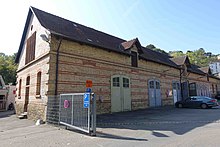Stuttgart latrine facility
The Stuttgart Latrinenanstalt or Latrinenentleerungsanstalt Stuttgart was a company of the city of Stuttgart for the disposal of faeces, whose depot was located on the grounds of the waste management in Stuttgart (AWS) . The company was founded in 1872 and was responsible for the removal and recycling of faeces until the general introduction of flush toilets towards the end of the 1950s.
history
Before the flush toilets and the alluvial sewer system were introduced, the faeces were collected in the company's own pits in Stuttgart . The faeces were removed by private entrepreneurs or farmers who used them as fertilizer. A general dissatisfaction with this system, which only worked irregularly and unreliably, led to the establishment of the municipal latrine drainage facility (or latrine facility) on July 1, 1872. In June 1873, the local council passed a "statute regarding the emptying of coffers in the city of Stuttgart".
The feces removal was carried out by urban workers. They used manually operated air pumps to empty the pits, and later steam pumps. The latrine workers' emergency trains consisted of horse-drawn carts that pulled the pumps, barrel wagons and hose wagons. The workers connected the sewage pits with the barrel wagons with a long hose that they unwound from the hose wagon. After this activity they were popularly referred to as "hose artillery". Most of the faeces were removed by train and used as fertilizer in the Stuttgart area.
From 1888 on, Tunzhofer Platz had its own depot between Mönchhaldenstrasse and Türlenstrasse. It comprised administration buildings, horse stables, magazines and workshops. In 1902 13 workers' houses were built on Tunzhofer Platz in the immediate vicinity of the latrine facility , which were preferably rented to latrine workers and employees of the nearby Prague cemetery .
From the turn of the 20th century, the dry toilets in Stuttgart were gradually replaced by flush toilets and connected to the alluvial sewer system. But in the 1950s, 8,000 lavatory pits had to be emptied by the city trucking office. The depot of the latrine facility was converted into a depot of the waste management in Stuttgart (AWS). Of the buildings that have been preserved, only the former horse stables from Building 5 are reminiscent of the original appearance. At the beginning of 2018, the Stuttgart city council decided to give up the historically and centrally located AWS depot on Türlenstrasse and to build 600 apartments on the site.
Others
- In 1911, the painter Reinhold Nägele documented the work of a deployment train of the latrine facility with his etching "Stuttgarter Abfuhrwesen (hose artillery)". The etching shows horse-drawn carts with a steam pump truck and two barrel wagons as well as a hose cart and the hose carriers that haul the hose snake on their shoulders.
- The writer Paul Eipper gives an anecdote about hose artillery in his childhood memories:
- “Those 'artillerymen' once pumped out the pits in the Catholic School for Daughters, just as classes were closing. Many nice Swabian girls left the school building, jumping amused over the snakes lying on the floor of the gymnasium. But two of the young women took their handkerchiefs out of the pompadour pouch, demonstratively pressed them to their nostrils and snorted as loudly and indignantly as they could, 'Pooh'. Whereupon the head artilleryman called out to the odor-sensitive daughter pupils with a respectful smile: 'You know what, you shit peppermint, then it doesn't stink!' "
literature
- Paul Eipper: A youth in Swabia: "the forged rose". Piper, Munich 1981, pages 96-98 (hose artillery).
- Tunzhofer district. In: Jörg Kurz: Northern history (s). About the dwelling and life of the people in the north of Stuttgart. Pro Nord district initiative, Stuttgart 2005, pages 112–115.
- A. Lauber: On the latrine issue, a study relating to the situation in Stuttgart. Schickhardt & Ebner, Stuttgart 1873.
- A. Sautter; E. Dobel: The removal and recycling of the fecal matter in Stuttgart. With 14 sheets of drawings, including the newly built urban railway loading station for faeces. Kohlhammer, Stuttgart 1880.
- Stadtentwässerung Stuttgart (Ed.): "Ain secretly Gemach ...": five centuries of wastewater disposal in Stuttgart. Sutton, Erfurt 2012.
- W. Weinberg: Guide through the main u. Residenzstadt Stuttgart, the participants of the 78th meeting of the Society of German Natural Scientists a. Dedicated to doctors by the city of Stuttgart and published by the management on their behalf. Grüninger, Stuttgart 1906, pages 76-77, 181-189, pdf .
Web links
Footnotes
- ↑ # Stadtentwässerung 2012 , pp. 38–41.
- ↑ # Stadtentwässerung 2012 , pp. 45–49.
- ↑ #Short 2005 , page 112.
- ↑ # Stadtentwässerung 2012 , pp. 106-107.
- ↑ Stuttgarter Zeitung, February 26, 2018 .
- ↑ Reinhold Nägele, Stuttgart Abfuhrwesen (hose artillery) .
- ↑ # Eipper 1981 , p. 98.
Coordinates: 48 ° 47 '29.9 " N , 9 ° 10' 35.9" E


